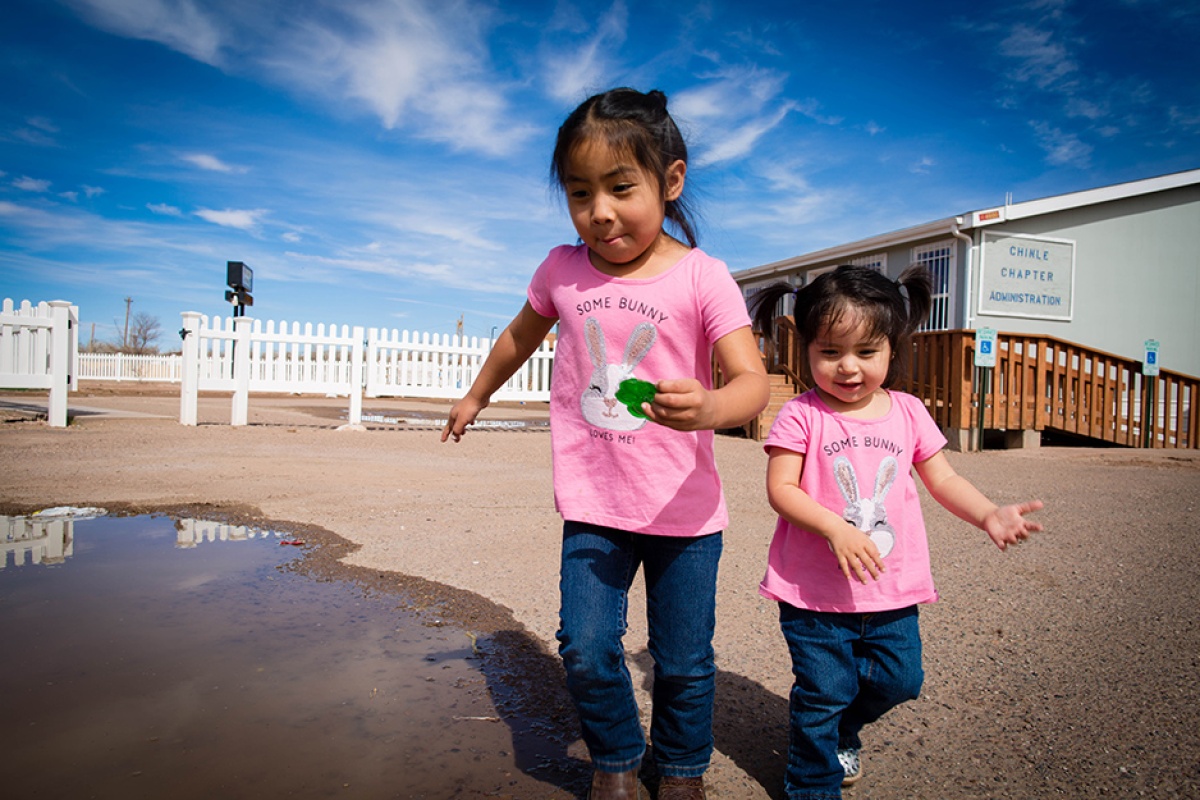Eating Well: Grocery Program Takes Off in the Navajo Nation
Posted on Jun 26, 2018

According to local legend, a group of high school students on the edge of the Navajo Nation created the first Piccadilly in late 2017. Half a year later, the homemade snack has spread throughout the largest Indian reservation in America. Cars now queue at roadside stands selling it for $3, highschoolers with driver’s licenses deliver it throughout the rez, and regional variations of the treat continue to pop up. What is Piccadilly? Essentially, a snowcone with sugary toppings. The most popular flavor combines orange-flavor syrup, Gummi Bears, watermelon Pop Rocks, strawberry Kool-Aid powder, and a diced pickle. The Navajo Times called it “an acid trip for your mouth.”
It’s also a small example of something much larger—the unhealthy forces that Partners In Health is battling, successfully, with a wholesome eating program.
The roots of the problem run deep.
Since the United States federal government forcibly resettled the Navajo in 1868, they have lived on land that is not exactly under their control, and one of the upshots is a lack of nutritious food. Just 13 grocery stores exist on the reservation straddling Arizona, Utah, and New Mexico—a reservation the size of Vermont, New Hampshire, and Massachusetts combined. A 2014 study found that the average resident drives three hours to stock up at a grocery store. Minimart-like trading posts, with tall aisles of chips and soda, reign. Not surprisingly, one in two Navajo children are unhealthily overweight. One in five adults suffer from diabetes—the third-highest rate in the world (after Pacific islands Nauru and Mauritius). And many tastebuds have grown unimpressed by mere Monster Energy drink. Hence, the Piccadilly.
But also hence the rebellion. In April 2015, Navajo leaders helped levy a small extra charge on potato chips and more, creating the first “junk food tax” in America. (Berkeley, California, quickly followed suit.) Researchers are unknotting the political and economic tangles around everything from produce distribution to farming. And the wholesome eating program supported by Partners In Health—or COPE, as it is known locally—has begun to do nothing less than reset the Diné dinner table.
Called the Fruits and Vegetables Prescription Program, or FVRx, it relies on an odd alliance. Doctors give patients, usually mothers, “prescriptions,” or vouchers, for a month’s worth of free fruits and vegetables for their families. The mothers spend the vouchers at their local store. And PIH reimburses the stores for the cost of the produce.
The program launched in 2015 at Teec Nos Pos trading post, in the Four Corners region. Since then, the hope has been to create a virtuous cycle, in which patients drive demand, which increases supply, which ultimately leads to everyone eating leafier and living healthier.

Is it working? In the early days, some store owners bought extra produce, and ate the loss when the grapes didn’t sell, for example. But stumbles like that appear to be in the past. All told, 1,688 people have benefited from FVRx food vouchers and education. Fully 85 percent of them have met the goal of eating five servings of fruits and vegetables per day. And after six months, almost a third of children who were initially overweight met the criteria for healthy weight. Prescriptions can now be filled in 26 grocery stores and trading posts. And 15 health clinics have adopted the FVRx program, from north to south, east to west.
“I wasn’t expecting health care providers to be above-and-beyond champions,” says COPE Executive Director Sonya Shin. “But the physicians really care.”
Many regions have formal cooking classes, where pediatricians answer questions about how to prepare eggplant or quinoa or other FVRx foodstuffs. At the Tonalea farmer’s markets, about 50 miles east of the Grand Canyon, physicians recently gave food demos, showing shoppers how to create paprika-spiced “flamin’ brocs,” a broccoli-based alternative to popular Flamin’ Hot Cheetos. (“We tried to introduce some more unusual or interesting things,” explains Dr. Margaret Ray.)
Stores are also embracing the program and introducing regional variations, welcomed by design. At Basha’s Diné Market in Window Rock, Arizona, there is a wheeled flower cart with baskets of bananas and apples that are simply free for children age 10 and under. In Tuba City, Arizona, a trading post is working with a food bank to pool their produce orders and lower costs. At Naschitti Trading Post in Farmington, New Mexico, signs encourage patrons, perhaps just stopping in to gas up their trucks, to formally join the program.
Families are signing on. Naschitti clerk Brenda Tsosie enrolled herself, as did her 4 year old, who is now a fan of carrots, thanks to FVRx, she says. (Green smoothies, sweetened with bananas, appear to be the most popular with kids.)

Shanna Rose Nez, who has four young children at home in the town of Many Farms, Arizona, loves FVRx. After she and her husband began earning too much to qualify for WIC—the nutrition program commonly called food stamps—but not enough to fill a grocery cart, FVRx allowed them to buy fresh fruits and vegetables.
“I take the kids to the grocery store and have them choose one vegetable they haven’t tried and then I cook it,” she says. If dinner feels too much like a game of Iron Chef, then she’s not ashamed to fudge.
“I usually end up going online to see if there is a recipe for it,” she says. “Like kale. What is this?!”
FVRx items might not unseat the Piccadilly as the trendiest food in the Navajo Nation this summer, but the future certainly looks bright.
On a Thursday afternoon not long ago, a 20-something in Pueblo Pintado, Arizona, surveyed the scene at a senior center. While the elderly played bingo, familiar grade-schoolers wandered around the tables.
“That one girl, she really likes tomatoes and grapes. That boy likes broccoli,” she said. “FVRx really works with kids.”

